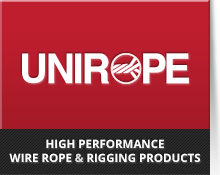|
Corrosion, while difficult to evaluate, is a more serious cause of degradation than abrasion. Usually, it signifies a lack of lubrication. Corrosion will often occur internally before there is any visible external evidence on the rope surface. This is one of the reasons why we developed PYTHON® wire rope with a plastic protected core. The plastic protects the core against corrosion and the user does not have to worry about undetected corrosion which may lead to a sudden and unexpected rope failure. |
Corrosion of the rope core not only attack the metal wires, but also prevents the rope’s component parts from moving smoothly as it flexes. Severe rusting leads to premature fatigue failure of single wires. When the rope shows more than one wire failure near a fitting, it should be removed immediately. To prevent abnormal corrosion, the rope should be kept well lubricated. In situations where abnormal corrosive action can occur, it may be necessary to use galvanized or stainless steel wire rope. |
Corrosion, Rope Removal and Cause
Rope Removal and Possible Cause
| Fault | Possible Cause |
|---|---|
| Accelerated Wear |
|
| Rapid Appearance of Broken Wires |
|
| Corrosion |
|
| Kinks |
|
| Excessive Localized Wear |
|
| Stretch |
|
| Broken Wires Near Fitting |
|
| Sheaves/Drums Wear Out |
|
| Pinching, Crushing, Oval Shape |
|
| Rope Unlays (Opens Up) |
|
| Reduction in Diameter |
|
| Bird Cage |
|
| Core Protrusion |
|



